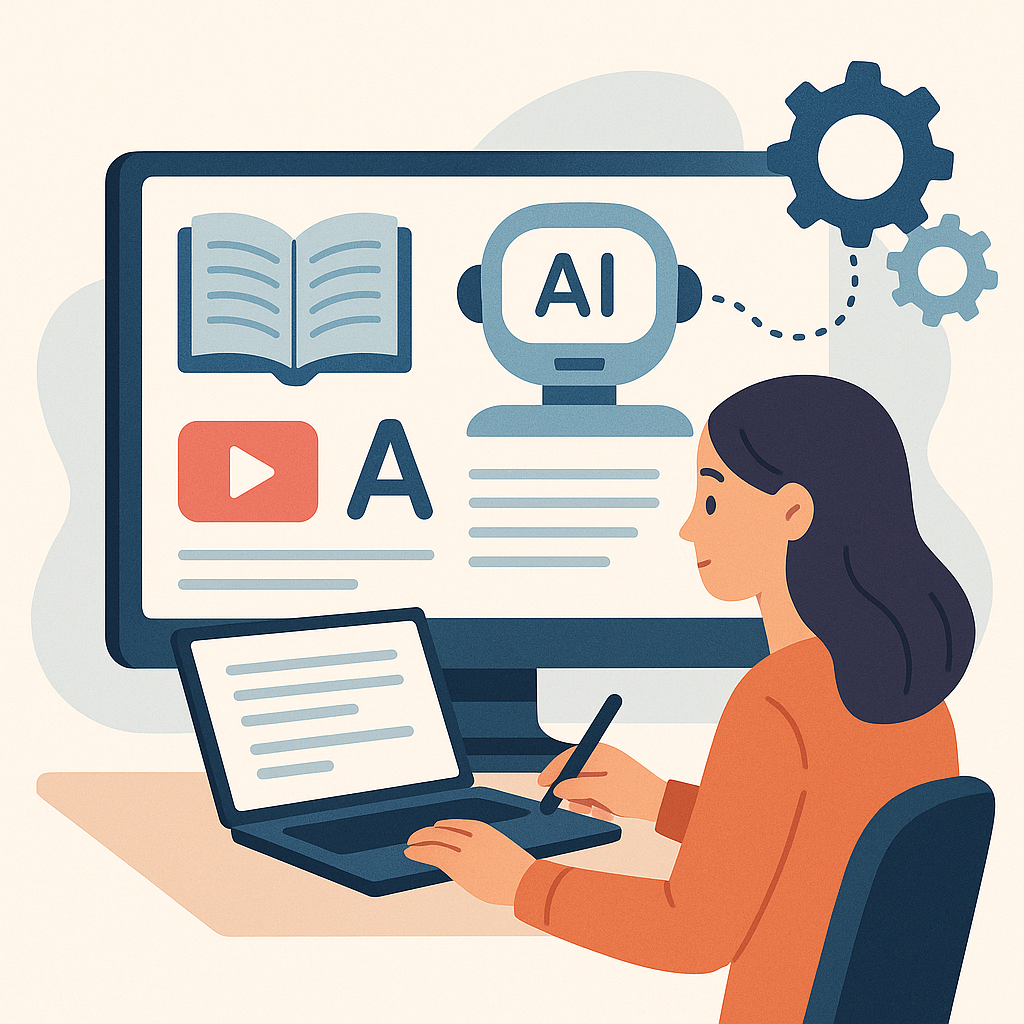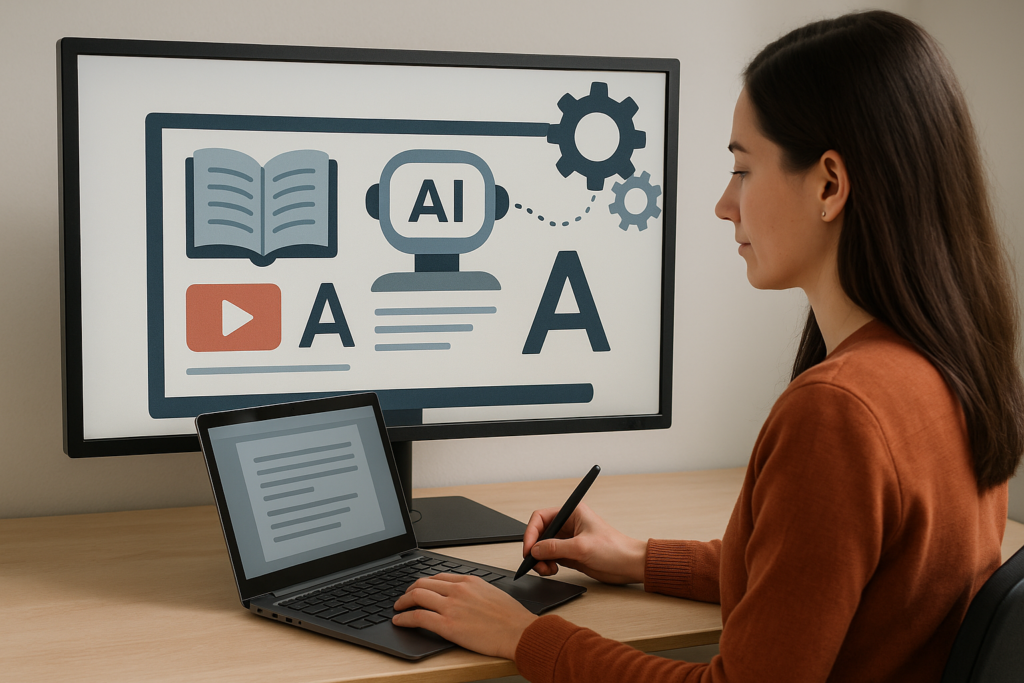Physical Address
304 North Cardinal St.
Dorchester Center, MA 02124
Physical Address
304 North Cardinal St.
Dorchester Center, MA 02124

Using AI to Design Learning Materials is no longer just an idea for the future—it’s something teachers are doing right now, every day.
Not long ago, Mrs. Khan, a high school English teacher, spent her evenings creating worksheets, quizzes, and lesson slides from scratch. It took hours. But now, with a few clicks, she uses AI tools to help her design content that fits her students’ needs perfectly. She saves time, feels less stressed, and can focus more on her teaching. This is the new reality in classrooms around the world.
Technology has always played a role in education—from chalkboards to digital whiteboards. But today, AI in education is changing the game completely. It helps teachers not just deliver lessons, but actually create the materials in smarter and faster ways.
In this blog, we’ll explore how educators are using AI to design learning materials, which tools they are using, and why it’s making such a big difference. You’ll also discover some of the best AI tools for creating lesson plans, plus real examples and time-saving tips.
Whether you’re a teacher looking to try something new or just curious about what’s possible, this guide is here to help. Let’s dive in.
Using AI to design learning materials means that teachers now have smart tools to help them plan and create lessons more easily. These tools, powered by artificial intelligence, are designed to save time and improve the quality of teaching materials. In the context of education, AI refers to technology that can understand input, learn from it, and produce useful results—like lesson plans, worksheets, or quizzes.
Instead of spending hours preparing content from scratch, teachers can use AI tools for teachers to get a head start. For example, if a teacher wants to explain a science topic, AI can quickly generate an outline, suggest activities, and even provide assessment questions. This doesn’t just save time—it also helps make the lessons more creative and engaging. AI can adapt the content to suit different learning styles or levels, making it easier to support every student in the classroom.
The real benefit of AI in education is how it changes the way learning materials are designed. It helps teachers focus more on student interaction while the technology takes care of the structure and support. With the rise of time-saving AI tools for educators, creating lessons has become faster, more personalized, and much less stressful. This means better experiences for both teachers and students.

Teachers today face many challenges—limited time, diverse student needs, and constant curriculum changes. That’s why many are now turning to AI tools for teachers. These tools are changing the way educators create and manage classroom content. From faster lesson planning to more personalized learning, using AI to design learning materials is helping teachers in ways that were not possible just a few years ago.
Here are the key reasons why educators are embracing this smart technology.
One of the biggest reasons teachers are using AI to design learning materials is to better meet the needs of each student. AI tools can adjust content based on age, skill level, or learning style. This helps teachers offer the right support or challenge to every learner—something that’s hard to do manually, especially in large classrooms.
Teachers often spend hours preparing lessons. But now, AI tools for teachers can take care of many routine tasks—like writing worksheets, planning quizzes, or creating slides. These time-saving AI tools for educators allow teachers to focus more on engaging with students instead of sitting behind a desk doing paperwork.
With AI in education, lesson planning becomes more informed. AI can suggest what to include or update based on what’s working and what’s not. This means the learning materials are always improving, making lessons more effective and aligned with real classroom needs.
Not every student learns in the same way. AI tools can create content in different formats—like audio for students with reading challenges or simpler text for learners who need extra support. Using AI to design learning materials helps teachers build an inclusive classroom where all students can learn and grow.
Using AI to design learning materials is easier than ever, thanks to a growing number of smart tools built just for educators. These tools help with everything from writing assignments to creating quizzes and visuals. They save time and make lessons more engaging for students. Below are some popular tools teachers are using in classrooms today.
One of the most popular AI tools for teachers is ChatGPT. This AI-powered assistant helps educators create summaries, write assignments, and even generate quizzes within seconds. Many teachers use ChatGPT to brainstorm ideas or draft structured lesson plans based on specific topics or grade levels. It’s especially helpful when you’re short on time or need quick inspiration. Whether you’re preparing a new topic or adapting an old lesson, ChatGPT simplifies your workflow and supports creative teaching.
Canva Magic Write combines the power of AI with beautiful design. Teachers can use it to write content for handouts, posters, infographics, and presentations—all in one place. It’s especially useful for visual learners and helps you deliver information in a way that sticks. Canva’s AI assistant helps you write while you design, saving time and keeping your classroom materials looking polished. It’s a favorite for teachers who want to combine writing and design without needing any graphic design skills.
Diffit is designed for teachers who want to personalize learning for every student. It transforms reading materials into simpler or more advanced versions based on student reading levels. This is incredibly useful in classrooms with mixed abilities. You can upload a text or enter a topic, and Diffit will provide reading content with questions tailored to your student’s needs. For educators focused on inclusive and differentiated instruction, this is one of the best AI tools for creating lesson plans that truly meet students where they are.
When it comes to making interactive classroom content, Curipod is a game-changer. It uses AI to instantly turn lesson topics into visually engaging presentation slides. Teachers just type in the subject, and Curipod creates structured, interactive content you can use in class. This tool is perfect for making student-centered lessons that spark participation. Using AI to design learning materials with Curipod makes it easy to keep students focused and involved
Kahoot! has long been a favorite for game-based learning. Now, with its AI features, teachers can generate quizzes automatically based on content summaries or textbook chapters. Just input your lesson content, and Kahoot! AI helps you turn it into an interactive quiz. It’s a great tool to test understanding in a fun and memorable way. This feature makes it one of the most time-saving AI tools for educators who want to increase engagement without hours of prep.
These tools are not just trendy—they’re practical. By using AI to design learning materials, teachers can focus more on teaching and less on tedious tasks. Whether you’re building lesson plans, adjusting materials for different learning levels, or trying to make learning more fun, these AI tools can transform your classroom experience.

Using AI to design learning materials is not just an idea for the future—it’s happening right now in classrooms around the world. Many educators are already seeing the benefits of AI tools for teachers and how these tools can make lesson planning easier and more effective. Let’s look at some real examples where AI is making a real difference in education.
In one high school, a teacher was struggling to meet the needs of students with different reading levels. To solve this, she started using an AI tool called Diffit, which helps create adaptive reading materials. By uploading a standard text, Diffit generated multiple versions that matched the students’ individual reading abilities. This saved the teacher hours of work each week and made it possible for every student to learn at their own pace. The students were more engaged because the materials felt just right for them—not too hard, not too easy. This story shows how using AI to design learning materials can make classrooms more inclusive and personalized.
At a college level, a professor began using generative AI tools, such as ChatGPT, to personalize lectures for students in large classes. Instead of delivering the same lecture to everyone, the professor used AI to create customized summaries and examples based on student feedback and questions. This allowed the professor to address different learning styles and interests within the same course. Students appreciated the tailored content and felt more connected to the material. The professor found the process saved time and improved student performance. This example highlights how AI tools for teachers can support deeper learning and engagement in higher education.
Many educators share similar positive experiences. One teacher said, “Using AI tools has transformed how I prepare lessons. I can focus more on teaching and less on paperwork.” Another commented, “AI helps me create quizzes and activities that match my students’ needs perfectly. It’s like having a personal assistant.” These testimonials reinforce the practical impact of using AI to design learning materials in real classrooms.
Beyond saving time, AI tools help teachers be more creative and responsive. They allow educators to experiment with different teaching styles and formats without extra stress. For example, AI-powered presentation tools help make lessons more visually interesting, while quiz generators keep students active and motivated.
These real-world examples show that using AI to design learning materials is more than just a trend. It is a powerful way to improve education for both teachers and students. AI tools for teachers make content creation faster, support personalization, and increase classroom engagement. As more schools adopt these technologies, we can expect to see even greater benefits in how students learn and teachers teach.
In short, AI is helping educators create better, more effective lessons. It allows teachers to meet the needs of diverse learners, save time on routine tasks, and bring fresh ideas into the classroom. For any teacher looking to improve their teaching and support their students, exploring AI tools for content design is a smart step forward.
Using AI to design learning materials offers many benefits, but it also brings important challenges and responsibilities. As more schools and educators use AI tools for lesson planning and content creation, it’s vital to understand the possible risks. In this section, we’ll explore some of the key ethical concerns and how teachers can use AI responsibly.
One of the biggest concerns with AI tools for teachers is protecting student data. Many AI platforms collect and analyze information to offer better results. This could include names, grades, reading levels, or classroom performance. If this data is not stored safely, there’s a risk it could be accessed by others without permission.
Educators must choose AI tools that clearly explain how they handle data. Always look for privacy policies and check if the platform follows rules like GDPR or COPPA. When using AI to design learning materials, it’s important to protect students’ privacy and never upload sensitive information without approval from your school or district.
AI tools learn from the data they are trained on, and sometimes that data includes bias. This means an AI might unknowingly create content that reflects stereotypes or unfair views. For example, reading passages or quiz questions might include biased examples or language that could make some students uncomfortable.
To prevent this, teachers should review all AI-generated content before using it in class. AI is a helpful tool, but it still needs human oversight. Using AI to design learning materials should never replace your professional judgment as an educator. Always check for fairness, inclusivity, and accuracy in the materials you share.
One fear some people have is that AI might replace teachers. But the truth is, AI works best when it supports—not replaces—human instruction. Teachers bring creativity, empathy, and classroom knowledge that no tool can fully replicate.
While AI tools for teachers can save time and offer new ideas, teachers should stay deeply involved in lesson planning and delivery. Your role is still essential. Think of AI as your assistant, not your replacement. Use it to handle routine tasks so you can focus on helping your students succeed.
Teachers should also guide students in understanding how AI works. If students use AI tools for writing or research, talk to them about originality, digital citizenship, and ethical use. Just as we teach safe internet habits, we should also teach smart AI habits.
Using AI to design learning materials responsibly means being aware of its limits. Make sure your students and fellow educators know that AI is a tool to support learning, not a shortcut to avoid thinking.
AI is changing education in many exciting ways. But to get the best results, we must use it thoughtfully. By understanding the challenges and addressing them with care, educators can make sure AI remains a helpful and ethical part of the classroom.
As AI becomes a regular part of classrooms, it’s important for teachers to use it wisely. A great way to begin is by starting small—pick one or two AI tools for specific tasks like making quizzes or summaries. Always review and personalize any AI-generated content to match your students’ needs and classroom goals. Using AI to design learning materials should support, not replace, your teaching style.
Educators should also stay informed. Many schools now offer training sessions on AI tools for teachers, which help you stay up to date on best practices and policies. At the same time, teaching students about digital literacy and responsible AI use is just as important as using the tools yourself.
Looking ahead, AI will play a bigger role in education. It will likely be built into learning management systems (LMS) and used widely in hybrid or blended classrooms. As it evolves, using AI to design learning materials may become the norm rather than the exception. With the right approach, AI can make teaching easier, more creative, and more inclusive—while helping students learn in smarter, more personalized ways.
1. What is AI in education?
AI in education refers to tools and technologies that help automate or improve learning experiences. These include content generators, quiz creators, adaptive learning systems, and more. Many teachers now use AI tools for teachers to save time and improve classroom engagement.
2. How can teachers use AI to design learning materials?
Teachers can use tools like ChatGPT, Canva Magic Write, and Diffit to generate lesson plans, visuals, quizzes, and tailored reading materials. Using AI to design learning materials makes it easier to personalize lessons for different student needs.
3. Are AI tools difficult for teachers to learn?
Not at all! Most AI tools for teachers are designed to be user-friendly. Starting with one task, like creating a summary or quiz, can help teachers build confidence while saving time.
4. Is it ethical to use AI in the classroom?
Yes, when used responsibly. Teachers should always review AI-generated content, protect student data, and stay updated on policies. AI should support—not replace—teaching.
5. What are the best AI tools for creating lesson plans?
Popular choices include ChatGPT, Canva Magic Write, Kahoot! AI, Diffit, and Curipod. These tools help teachers create, adapt, and share high-quality resources quickly.
If you found this guide helpful and want more tips on AI in education, lesson planning, and smart digital teaching strategies, visit icebergaicontent.com. We’re here to support your journey with AI-powered education tools that truly make a difference.